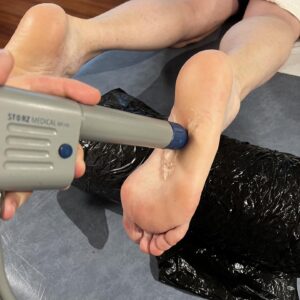Understanding Shockwave Therapy: An Overview
In contemporary medicine, the noninvasive miracle that is Shockwave Therapy, commonly referred to as Extracorporeal Shockwave Therapy (ESWT), stands out as a revolutionary treatment option. Ultrasonic waves are used to treat musculoskeletal conditions, particularly those that involve connective tissues such as ligaments and tendons.
 The Mechanism of Shockwave Therapy
The Mechanism of Shockwave Therapy
From its most fundamental level, Shockwave Therapy involves applying sound waves to certain areas of damage, with the goal of encouraging the body’s natural healing mechanisms. This method enhances blood circulation, reduces pain, and promotes tissue regeneration, providing a comprehensive approach to the healing process.
The Benefits of Shockwave Therapy
- Facilitation of Natural Healing: Shockwave Therapy accelerates the body’s natural healing process by enhancing blood flow and cellular repair, expediting tissue recovery.
- Non-Invasive Nature: A key advantage lies in its non-surgical character. It provides patients with a safer alternative to invasive procedures, minimizing risks and recovery periods.
- Pain Alleviation: Through targeted treatment, Shockwave Therapy effectively reduces pain stemming from various ailments, offering relief without needing prolonged medication or invasive interventions.
- Enhanced Mobility: Patients often experience improved mobility post-therapy, as underlying causes of discomfort are addressed, paving the way for enhanced movement and comfort.
- Cost-Effectiveness: In many cases, shockwave therapy is a more cost-effective option than prolonged medication or surgical interventions, though individual healthcare needs and policies may influence this aspect.
- Limited Side Effects: While no medical intervention is devoid of risks, Shockwave Therapy generally has fewer adverse effects than surgical procedures or long-term medication usage.
Applications of Shockwave Therapy
Shockwave Therapy has gained prominence for its efficacy in treating an array of musculoskeletal and soft tissue conditions, including:
- Foot Conditions: Notably Plantar Fasciitis and Heel Spurs.
- Tendinopathies: Covering Achilles Tendonitis, Tennis Elbow, and Jumper’s Knee.
- Knee and Bone Issues: Including Stress Fractures and Delayed Bone Healing.
- Calcific Conditions: Calcific Tendonitis with Shoulder Impingement.
- Chronic Inflammation: Addressing pain stemming from chronic inflammatory conditions.
- Tissue Concerns: Encompassing Scar Tissue Degradation and Non-Healing Wounds.
Exploring Various Shockwave Technologies
- Electrohydraulic Shockwave Therapy (FSWT): Utilizes focused shockwaves, ideal for addressing pain, soft tissue injuries, and musculoskeletal conditions, along with innovative applications like Erectile Dysfunction and Regeneration Therapy.
- Linear Low-Intensity Extracorporeal Shockwave Therapy (Li-ESWT) Leverages low-energy shockwaves to promote healing and tissue regeneration, which is beneficial for injuries, back pain, and joint discomfort in the musculoskeletal system.
- Electromagnetic Shockwave Therapy (FSWT): Employed in cancer treatment, spinal cord damage, brain tumours, and uterine fibroids, harnessing powerful electromagnetic shockwaves for targeted therapeutic outcomes.
- Piezoelectric Shockwave Therapy is specifically designed for treating kidneys and gallstones. It utilizes high-energy shockwaves to disintegrate stones effectively, providing a noninvasive outpatient solution.
- Radial Shockwave Therapy (RSWT): Offers a non-invasive approach, generating unfocused shockwaves over a wider area to stimulate tissue repair and alleviate conditions like tendinitis, bursitis, and plantar fasciitis.
Distinguishing Between Radial and Focused Shockwaves
The therapeutic advantages of radial and focused shockwave treatments are comparable; nevertheless, their applications and outcomes are distinct. Utilising Radial Shockwave Therapy allows shockwaves to be distributed across a larger area, making it an excellent method for treating more substantial tissue areas. In the same vein, Focused Shockwave Therapy can concentrate energy on specific areas, enabling it to provide accurate therapy for local problems.
High vs. Low Energy Shockwaves
The ailment being treated can determine whether high-energy (focused) or low-energy (unfocused) shockwaves are used in shockwave therapy. In contrast to high-energy shockwave treatment, which can precisely target particular concerns, low-energy shockwave therapy promotes overall tissue repair and provides relief from a wide range of musculoskeletal ailments and chronic pain syndromes.
Accessibility of Shockwave Therapy
Specialised medical centres, clinics, and physiotherapy facilities provide Shockwave Therapy services. These facilities are outfitted with cutting-edge equipment and manned by trained medical experts who can provide individualised treatments specifically designed to match each patient’s requirements.
Shockwave Therapy is a leading example of innovation in noninvasive medical treatments. It provides a wide range of advantages and uses for treating a wide variety of conditions that affect the musculoskeletal system. In contemporary medical practice, the power of this substance to facilitate natural healing, reduce pain, and improve mobility continues to alter the appropriate standards of care.
Brought To You By: Shockwave Therapy Preston
Extracorporeal Shockwave Therapy (ESWT) References:
American Academy of Orthopaedic Surgeons (AAOS):
Website: https://orthoinfo.aaos.org/
The AAOS offers patient education resources and articles on various orthopaedic treatments, including ESWT.
Mayo Clinic:
Website: https://www.mayoclinic.org/
Mayo Clinic provides comprehensive information on medical conditions and treatments, including ESWT, in their patient care section.
WebMD:
Website: https://www.webmd.com/
WebMD offers health information and resources for patients, including articles and videos explaining ESWT and its applications.
National Institute of Arthritis and Musculoskeletal and Skin Diseases (NIAMS):
Website: https://www.niams.nih.gov/
NIAMS, part of the National Institutes of Health (NIH), provides research-based information on musculoskeletal conditions and treatments, including ESWT.
The post Exploring the Potential of Extracorporeal Shockwave Therapy appeared first on MCR Therapies.
The Article A Look At Extracorporeal Shockwave Therapy (ESWT) appeared first on MCR Therapies.
The Article A Look At Extracorporeal Shockwave Therapy (ESWT) Was Found On https://limitsofstrategy.com
The Article A Look At Extracorporeal Shockwave Therapy (ESWT) First Appeared ON
: https://ad4sc.com













